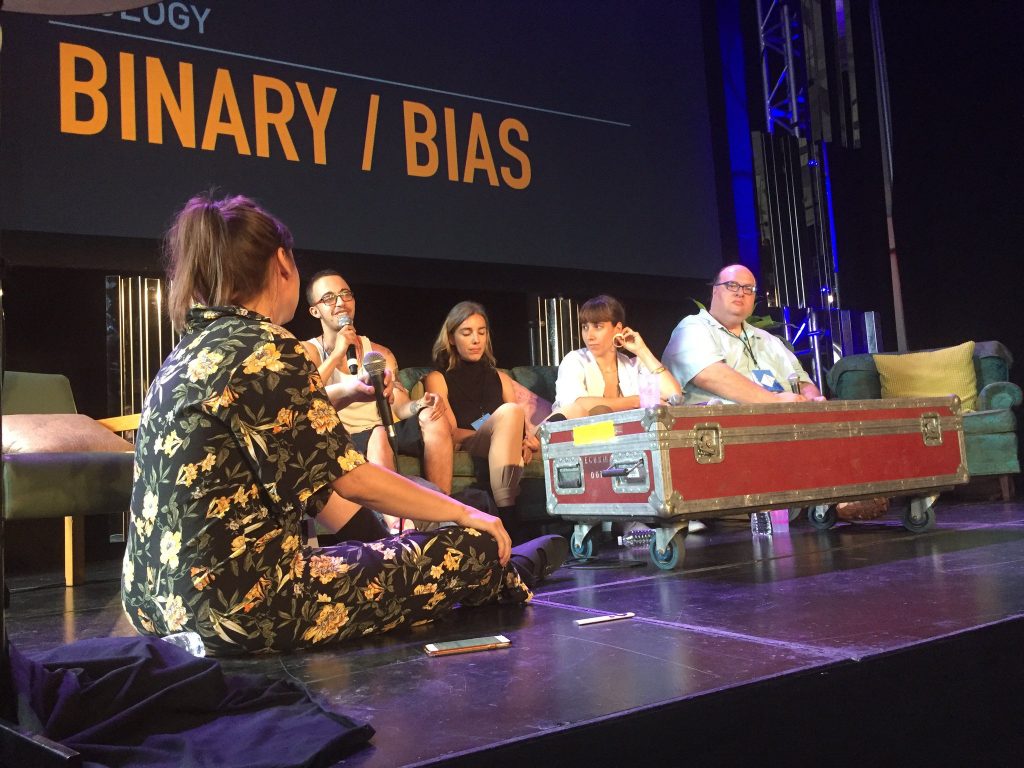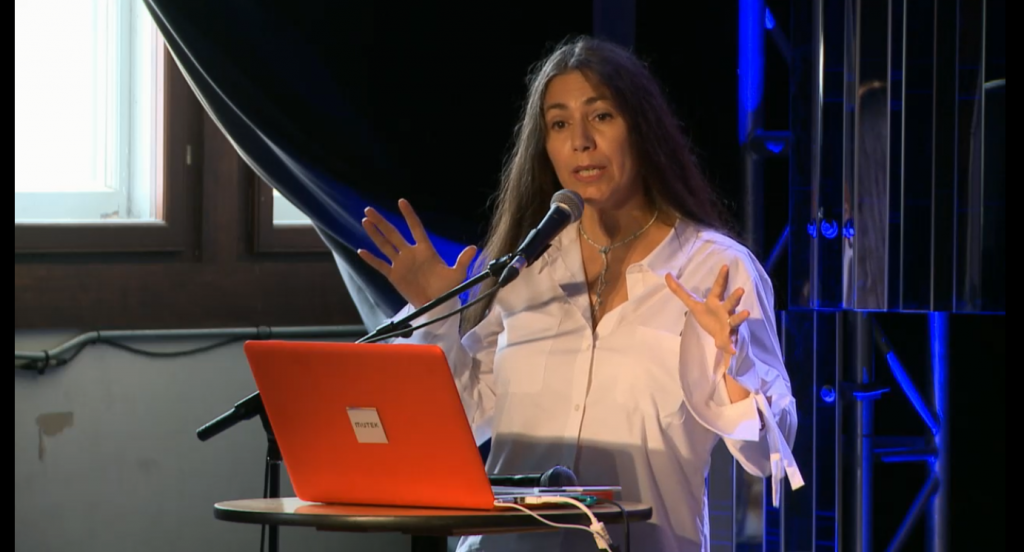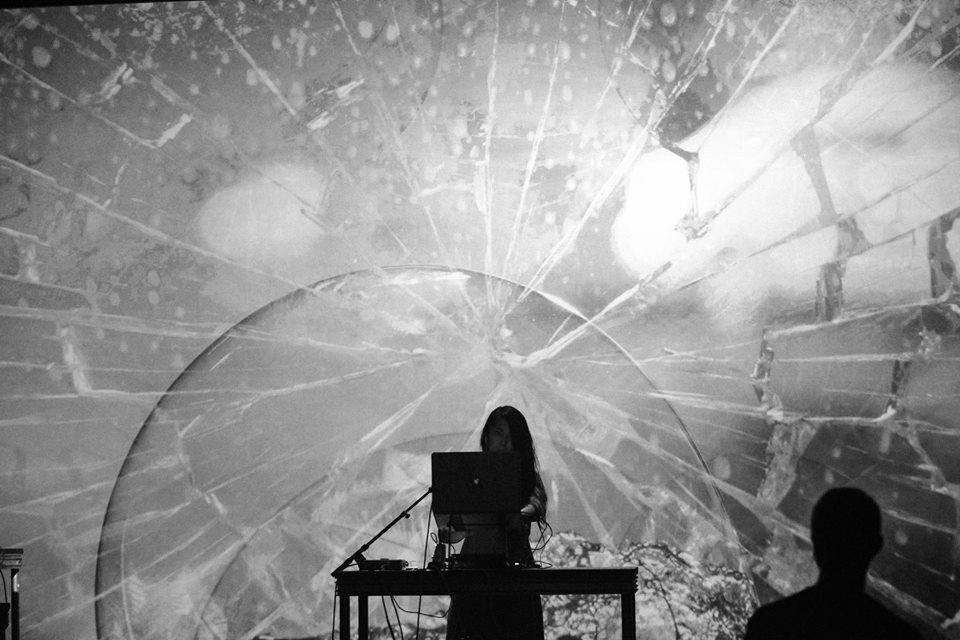“As many dreams of freedom as we can get” – on gender and inclusivity in electronic music at the Mutek festival’s “Keychange :: Amplify” symposium
I recall an interaction when I was travelling to Montreal for the first time in the summer of 2017, when a fellow activist for gender balance in music wrote to me: “Good luck, it’s a great city. Perhaps you could get in touch with Mutek, they will probably need some discussion on gender and diversity…”. Interestingly enough, a year later, on 21–22 August 2018, the Mutek Festival (International Festival of Digital Creativity And Electronic Music), one of the most influential electronic music festivals in North America (now expanded to 6 other cities all over the world), offered the audience of its 19th edition a special two-day symposium on the issues of gender, inclusivity, and diversity in electronic music.[1]
The symposium’s name “Keychange :: Amplify” reveals the dual institutional background behind the event. The Keychange initiative, run by the UK-based PRS Foundation, is known for promoting and supporting female musicians. Additionally, the organization is encouraging a growing international network of music festivals that have pledged to achieve a 50/50 gender balance in their line-ups by the year 2022.[2] The symposium in August was the result of Mutek’s long-term collaboration with the Keychange, as well as with the Amplify, another initiative dedicated to women artists. As a multinational organization, Amplify is led by the British Council, Mutek, Somerset House Studios (an experimental artist workspace in London), and supported by the Canada Council for the Arts.
Beyond a one-channel discussion
Recognizing this abundant international network and its multiple trajectories of reciprocal support between governmental institutions, independent organizations, artists, and curators that allowed for the organization of an event like “Keychange :: Amplify” is important for at least two reasons.
First, it highlights the role that the relationship between grassroots awareness and the larger institutionalized politics of inclusion plays in reshaping the contemporary electronic music scenes across multiple Western countries. It warrants some optimism for the future of such scenes to see the aspirations and initiatives of long-time artists and activists finally align with the direct financial and political actions taken by governmental institutions. One need look no further than German speaker and panellist Susanne Kirchmayr, aka Electric Indigo, who started the female:pressure network from scratch 20 years ago. Despite tangible progress in several countries, it is very clear that such measures are affordances of a geographically privileged context.[3]
Second, the variegated institutional background of the “Keychange :: Amplify” was mirrored by the great variety of speakers, panellists, and topics featured during the event. In fact, one of the conference’s great assets was that multiple stakeholders were called to participate in an effort to answer the big questions about diversifying the music industry. Participants included festival curators, artists, decision makers and institutions, as well as researchers and scholars (Marie Thompson’s presentation on the sonic cyberfeminism and Analog Tara’s presentation on the feminist movement in electronic culture were definitely some of the symposium’s highlights). Certain panels were dedicated to particular groups, allowing for a deep dive into the issue of inclusion from various angles. The “Beyond the Why: A Diversity in Curation How-To” panel gathered six curators from Canada, the US, the UK, and Germany to exchange experiences and discuss challenges of diversifying the industry from the curatorial perspective. The “(Re-en)gendering the Arts & Industry: Institutional Action” panel, which addressed the role of institutions, policy-makers, and governmental funds in striving for equity in art, was something of a rarity at similar conferences.
In fact, the resultant multi-layered narrative established at the symposium was a feat that many panellists mentioned as an effective model they would like to see again for future discussions and actions. As Heather McDermind from the Vancouver New Music organization pointed out in the closing panel “Gathering The Momentum: Possible Futures”, making the electronic music industry inclusive should be an ongoing process and a larger collective effort. For scholars, this might mean raising awareness through their research. For artists: giving up space and voice to those who are underrepresented. For curators: taking responsibility for their line-ups. For policy-makers: consulting those social groups that normally don’t have a voice. And finally, for everyone: checking one’s own biases and listening, which would lead to self-educating and challenging one’s standpoint. For instance, what are my biases? What allows me to remain comfortable in the system I am part of? Am I willing to give up some space?
Beyond “representation” and line-ups
While the 50/50 gender quota in music festivals seems like the ultimate goal (or, as the Keychange Project Manager Jessica Partridge explained, at least a clear direction) for the Keychange network initiators and participants, it barely seemed like a starting point for the big questions posed during the conference: Does equal representation always bring actual equality? Is presence equal to justice? The problem of representation was raised in one of the first panels, “Hot Buttons: Quotas, Biology, The Meritocracy and More”, during which US artist and curator Lauren Goshinski pointed to a common dilemma female artists face whenever they are invited to an initiative like Keychange. As she stated:
I don’t want to be invited to something just because I’m a female-identifying artist, right? When it’s a self-identified group, using your binaries or labels is seen as liberating or an act of resistance, but when you’re being asked to identify yourself (…), it can be a simultaneously liberating and also reinforcing mechanism to the problem that we’re in.
In other words, artists striving for the audiences’ appreciation of their work probably do not want to be invited to a festival, just because they are identified as a member of a marginalized group, i.e. a woman / a trans person / black / gay etc. But this necessarily raises the issue of how to strive for justice in musical scenes without perpetuating the exclusionary consequences of labelling. Magdalena Olszanowski, a feminist artist, teacher, and researcher at Montreal’s Concordia University proposed that we allow ourselves to choose how we go about our identity according to the space that we are in. This means speaking about issues related to one’s own identity politics when that space is designated for such topics, rather than merely embodying a token representation of marginality. Another important aspect of representation that panellists discussed was that of ownership and power within the larger structures behind the organization of music festivals. For instance, filling line-ups with female names will never reshape the scene if a festival’s programming board is a male monolith.

“Hot Buttons: Quotas, Biology, The Meritocracy and More” moderated by Lauren Goshinski. Starting from the left: Lucas Charlie Rose, Magdalena Olszanowski, Roxanee Arsenault, Jonathan Sterne. Source: https://twitter.com/oshieposhie
Jonathan Sterne, a McGill University professor well-known for his scholarly work in media studies and sound studies, and Olszanowski noted that academics struggle with a very similar dilemma when it comes to research and pedagogy. For instance, Sterne mentioned the difficulties of trying to write histories of transgender people’s participation in sound culture –many of the people in question choose not to identify as trans after their transition. That also holds true for any scholar who has ever tried to enrich queer historiography but must contend with extremely limited historical sources due to the decades and centuries of shame and erasure of non-normative lifestyles and identities. On the pedagogical side, Olszanowski pointed out that the problem of representation becomes particularly salient in classrooms where women are missing from curricula. She shared her tactics as a teacher which is to offer a kind of revisionist history of electronic music full of women figures as an inherent element of a class, before bringing up all the issues concerning discrimination and gender.
Olszanowski’s voice advocating against the “exceptional women” narrative was clearly echoed in Marie Thompson’s lecture “Sonic (Cyber)Feminisms: Strategies, Contestations and Possibilities.” Thompson is an author of Beyond Unwanted Sound: Noise, Affect and Aesthetic Moralism and together with Annie Goh co-leads the Sonic Cyberfeminisms project, which critically examines the intersections of gender, sound and technology. During her presentation, she addressed three fields of what she calls sonic feminisms: education, network building, and representation. As she argued:
Network building has ben important inasmuch it can provide the important valuable support of collectivity and community. Indeed, networks help to disrupt the industry’s tendency to individualize and exceptionalize women artists, reifying them as a rare commodity. (…) Sonic feminist networks respond to the “exceptional” with the “many.”
Given the long history of marketing women in electronic music as a “special find”, Thompson stressed the importance of sonic feminisms in the context of capitalism, as they allow the replacement of the “exceptionality” rhetoric with building networks.
Beyond second-wave feminism
What did the “Keychange :: Amplify” Symposium participants think about when they discussed the idea of an inclusive electronic music scene? Putting aside the myriad of problems that characterize the current career of the buzz word “intersectionality,” it would be difficult to answer the above question otherwise. The commonplace “50/50” narrative for festival programming essentially remains silent about non-binary people (a concern addressed by Susanne Kirchmayr in the closing panel), barely addresses problems experienced by transgender people in the electronic music scene (which were widely discussed by Lucas Charlie Rose, a hip hop artist and producer known for his activism in the black trans community); neither does it touch upon any of the other bases of exclusion experienced by people marginalized in the industry, such as race, age, sexual orientation, or disability.
I recognize that some effort had been made by the organizers of the symposium to reduce the evident shortcomings of the gender parity approach, particularly by inviting contributions from indigenous artists and artists of colour. Yet over the two days, the great majority of speakers mentioned pervasive and urgent issues in the movements towards greater inclusion and diversity in the electronic music scene, including a Western focus, the underrepresentation of the global south in electronic music networks, and a general need for a greater diversity in the music industry. Still, a few participants represented some of those marginalized voices. Lucas Charlie Rose brought important insights on the issues of racism coming from his experience as a black trans artist. Moreover, two indigenous artists were invited to speak about their artistic and activist work: Kite aka Suzanne Kite, an Oglala Lakota performance artist, visual artist, and composer, who co-runs an independent label record Unheard Records, and Skawennati, a local artist and educator born in Kahnawà:ke Mohawk Territory, known for her new media projects and the co-director of the Aboriginal Territories in Cyberspace research network. The voices of North-American indigenous female artists in the sonic/musical feminist movement are particularly important, as they often question traditional Western modes of listening and ways of imagining sound, and necessarily pluralize the available narratives on sound, body, and gender.

“An Avatar is Born”: presentation by Skawennati. Source: https://livestream.com/accounts/195689/events/8333033/videos/179234757
What particularly stood out for me with regard to the need for diversity and intersectionality in electronic music industry, was Analog Tara’s keynote presentation “What Does Field Transformation Sound Like? Mapping Feminist Movement in Electronic Music & Sound Cultures”, where she explained that acting for gender diversity in electronic music is inherently intertwined with the issues of personal and social identity, wider cultural experience as well as racial and economic justice. As she said:
(…) creative expression is an embodiment of freedom. And more often, creative expression embodies many different dreams or yearnings that move in the direction of freedom. And we need as many different dreams of freedom as we can get.
***
The 19th edition of Mutek achieved the goal of performance parity three years before the Keychange project’s 2022 deadline. At the same time, as has been said multiple times during the “Keychange :: Amplify” symposium, this process is never completed, and when so much work has already been done, there is always even more work left to do.
As Olszanowski put it:
There is a certain level of work that we have to do. It is not to make other people do the work for you, but to do the work. (…) And it’s really f****** hard. And if it’s not hard, you’re probably not doing the work. It’s got to hurt a little bit. Cause we are within these structures (…). It’s comfortable. And so sometimes it is just giving up the space.
What are my biases?
What allows me to remain comfortable in the system I am part of?
Am I willing to give up some space?
***
[1] New Mexico, San Francisco, Barcelona, Buenos Aires, Tokyo, Dubai. See: http://www.mutek.org/en/
[2] A full list of festivals that have joined the Keychange initiative can be found here: https://keychange.eu/blog/full-list-of-festivals-signed-up-to-keychange/. So far, Katowice JazzArt Festival is the only Polish festival on the list.
[3] This is also mirrored in the female:pressure network’s geographical structure which Susanne Kirchmaye shared during her talk: 91,9% of female:pressure’s members live in Europe or North America, with as many as 31,3% of all members living in Germany.


